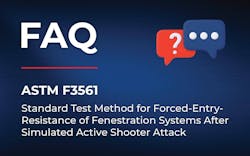Groundbreaking School Security Standard Protects Students During Active Shootings
In the wake of the tragic rise in active shooter incidents at schools, the National Glass Association (NGA) took swift action in 2021 by forming a dedicated School Security Task Force. Their mission? To develop robust standards for windows and doors (known as fenestration systems) to protect students and staff.
Working at an unprecedented pace with ASTM International, the task force accomplished two critical goals in just 8 months:
- Created a test method to evaluate fenestration performance under attack
- Published ASTM F3561-22: Standard Test Method for Forced-Entry Resistance of Fenestration Systems After Simulated Active Shooter Attack
While there are other performance standards that already evaluate fenestration systems for forced entry, ASTM F3561 is the only standard that evaluates the ability of windows and doors to withstand repeated impacts and maintain integrity even after being compromised by multiple gunshots – which is exactly what happens in active shooter events.
Why is this so critical? According to the NGA’s school security one-pager, the average length of a school shooting is 8 minutes, and the average time for first responders is 3 minutes. ASTM F3561 aims to prevent or drastically delay attackers from breaching school premises, buying precious minutes to execute emergency plans and enable law enforcement response.
The implications of this standard are nothing short of life-saving. For the first time, architects can now incorporate ASTM F3561 into the core design and performance criteria for new schools, major renovations, and other high-risk commercial, healthcare and industrial facilities. When every second counts, security rated windows and doors become the first line of defense.
As a specialty glass manufacturer, SAFTI FIRST has been working hard to be part of the solution. As our company name suggests, safety is our top priority. In addition to being the only vertically-integrated, single-source, USA-manufacturer of advanced fire rated glass, frames, doors and floors, we’ve invested in a state-of-the-art laminated glass line that allows us to manufacture glazing products that protect against forced-entry, bullets, blast, hurricane, UV, sound, and more.
With our unique manufacturing capabilities, we are currently designing full window and door assemblies that can meet the new ASTM F3561 standard. These can be combined with our existing fire rated products, and can be further enhanced to include energy performance, bird-friendly, decorative, and more.
We are also invested in educating architects, school districts, superintendents, faculty managers, lawmakers and parents about ASTM F3561. Below are the most frequently asked questions about this groundbreaking school security standard.
Why focus on windows and doors?
Windows and doors can be the first line of defense. They allow school personnel to see potential threats and first responders to visually assess the situation. When equipped with security features such as forced-entry or bullet resistance, it helps to maintain a secure perimeter that functions 24/7, unaffected by power outages.
During the Covenant School shooting in Nashville last March 2023, the shooter was able to gain entry to the school by shooting through a pair of locked glass doors. In surveillance videos released by the Nashville police department, the bullets shattered the glass immediately, and the shooter was able to kick the rest of the glass shards, duck under the door’s panic bar and walk in.
This is the scenario that the ASTM subcommittee had in mind when they developed the active shooter standard. The entrance doors were locked, but the glass used in these doors created a weak point because it was easily shattered and breached after being fired at by an assault-type rifle.
Is ASTM F3561 a ballistic standard?
ASTM F3561 is an enhanced forced-entry standard, not a ballistic standard. Although the test includes firing shots from an AR-15, the test allows the bullets to go through. What the test evaluates is how well the fenestration system remains intact after it has been significantly weakened by gunshots.
During their study, the NGA School Security Task Force learned that keeping the glass intact (or at least partially intact) during the initial stages of an active shooting provides many life saving opportunities. With the shooter assuming that the windows and doors are the weak point, having security glass in these areas act as an element of surprise, which helps in preventing the shooter from entering the premises or significantly delaying their progress. As mentioned earlier, this buys critical time for first responders to arrive onsite, and for schools to enact their protocols to protect students and staff.
What is ASTM F3561 and how is it performed?
In this article, Julia Schimmelpenningh, chair of the ASTM committee that developed F3561 and technical engagement manager for Eastman Chemical Company, describes the test as “a weakening of the system by ballistic attack, followed by a series of impacts. This is to simulate a shooter trying to break out the glass or locking mechanism with bullets and then approaching it and impacting the system to open a space that either allows reach-through to unlock a window or door, or creates an opening large enough to walk through.”
The test is two-fold:
- First, the glass is shot ten times by an AR-15 type assault rifle in a tight circular pattern, with two shots burst at the center of the circle. For doors, the lock is also shot five times in a diamond pattern, with the center shot aimed at the lock itself.
- If there is no opening through which a 6-inch sphere can pass through, an impact test follows. The glazing is struck with a 100-lb pendulum dropped at eight different drop heights. It starts at level 1, with two impacts at the same drop height. It moves to the next level if the glazing passes, up to level 8 with a cumulative total of 3,600 ft. lbs. This repeated impact is to simulate the shooter trying to break through the glass after it has been weakened by the AR-15.
Having multiple levels of forced-entry resistance allows the schools and school designers to make individual assessments based on risk level and budget.
While other forced entry test standards already exist, ASTM F3561 is the only published safety standard that takes into account the weakening of the window and door system with a ballistic attack before administering forced-entry. This is the scenario that happens during active shooter events, and exactly what ASTM F3561 addresses.
Click here to download the full ASTM F3561 test standard.
Does ASTM F3561 apply to the glass, window frame or door?
It is important to note that ASTM F3561 applies to the entire assembly – not the individual glass, window frame or door components. They have to be tested and certified together to ensure that the entire system performs as it should be in the event of an active shooter event.
Is ASTM F3561 in the International Building Code (IBC)?
Right now, there is no building code mandate that requires security glazing in schools. However, the NGA does have a code proposal in it to include ASTM F3561 as a minimum safety standard for schools in the 2027 version of the IBC.
This makes it all the more important for school architects to start specifying ASTM F3561 now as a design and performance criteria for new school projects or major renovations. It would be a lost opportunity to wait 3 years before a mandate is within sight.
A good place to start would be in exterior windows, entrances and secure vestibules. These all contribute to perimeter hardening without being harsh. By using security glass, architects still allow access to natural light and a visual connection to the outdoors – both of which contribute to a welcoming learning environment where students and staff can thrive.
If you are currently working on school projects or in need of advanced fire or security rated glazing products, contact us today at 888.653.3333 or visit us online at safti.com or safeglassforschools.com.


